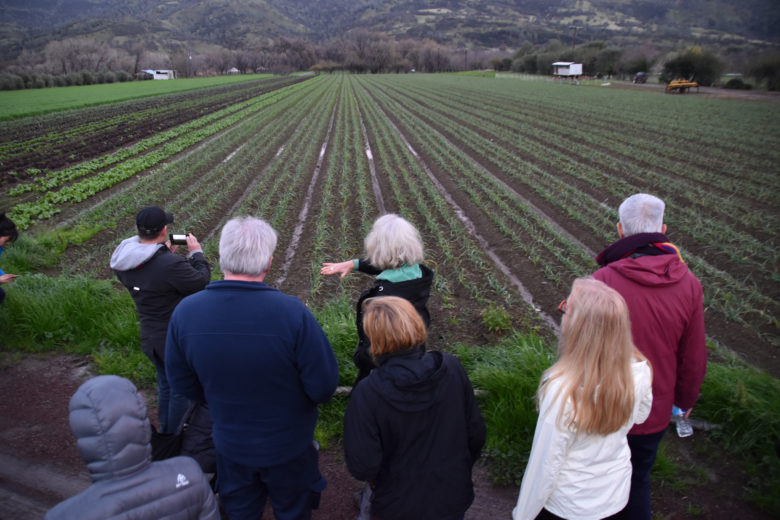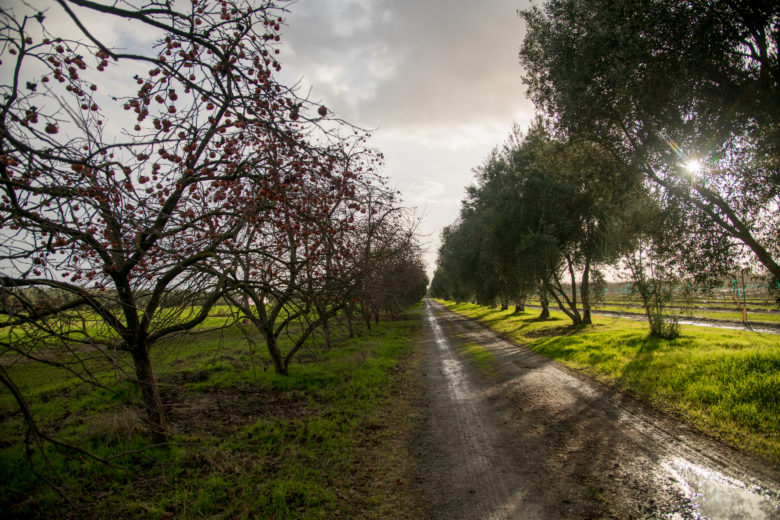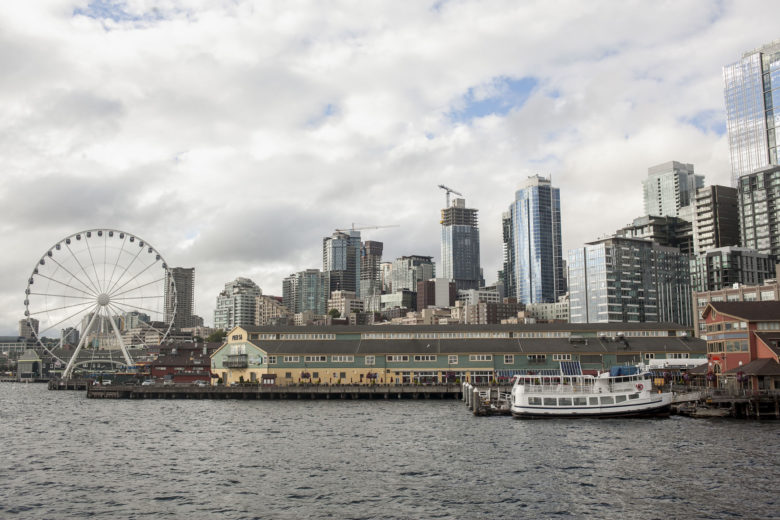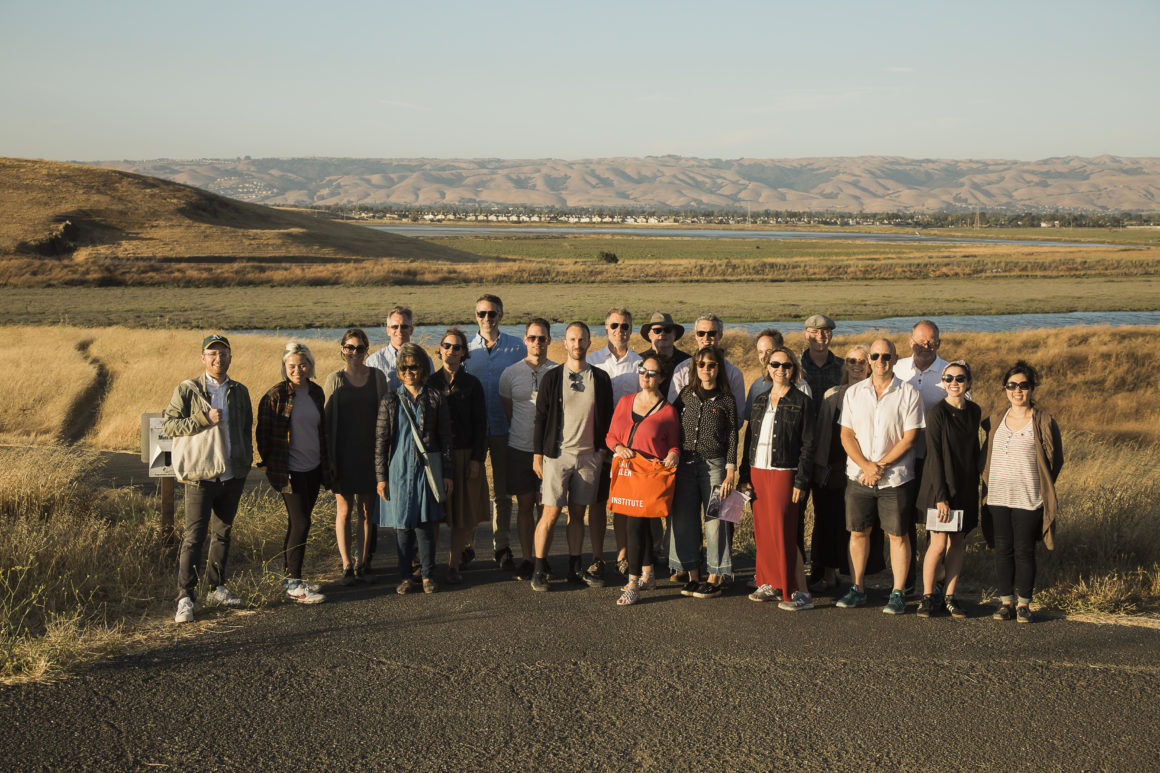
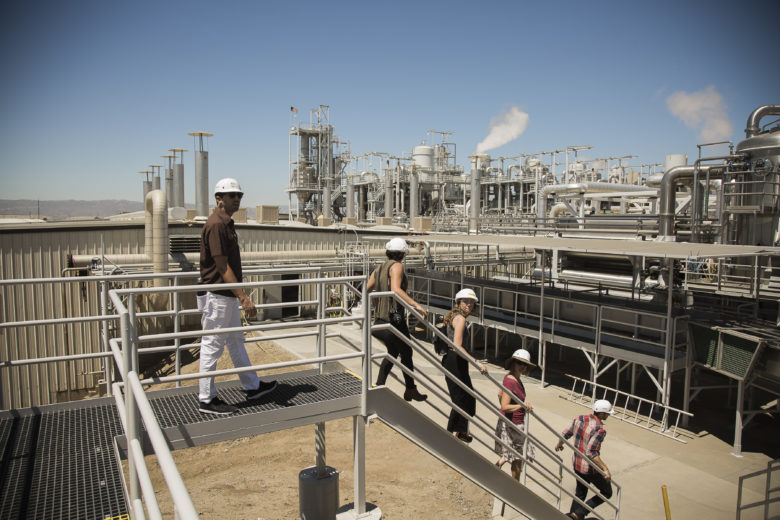
Van Alen Institute welcomes guest writer Sahoko Yui, PhD, a lecturer in the University of California Davis and University of California Berkeley Department of Landscape Architecture and Artist in Residence at Blake Garden, who attended the Climate Council’s inaugural trip to the Central Valley of California in July 2018. This Story provides background on the issues we explored during the trip as well as Dr. Yui’s expert insight on the opportunities for design. (Read more about the council here.)
The Intergovernmental Panel on Climate Change (IPCC) has found that industrial agriculture is the largest contributor to greenhouse gas emissions. Despite the extent and widespread recognition of the impact of food on climate change, design efforts for system-wide change of food systems are in the early stages. Current design efforts to avert the negative impacts of food-related climate change primarily focus on local place-making (e.g. urban gardens) and have yet to expand design thinking to larger scales and broader impacts. While redesigning and improving local community food sources and management is important for resiliency, they do not address the larger systemic issues embedded in food systems that play a significant role in climate change and mitigation. Designers and planners are uniquely situated as professionals who think abstractly, broadly, and radically while applying their ideas practically and locally. It is appropriate that the Van Alen Climate Council gathered in California, the source of most of the nation’s produce production, to learn about the nation’s food system.
California agriculture is a $50 billion industry and generates over $100 billion in related economic activity, producing over a third of the country’s vegetables and 2/3 of the country’s fruits and nuts. California is also one of the main producers (99% or more) of the following crops: olives, peaches, dates, raisins, walnuts, plums, pistachios, artichokes, and almonds. The most productive agricultural region is the Central Valley, a 450-mile long stretch of flat land from Redding to Bakersfield. The Central Coast has also been a significant player in the produce industry, as it’s responsible for producing more than 80% of the nation’s berries and produces most of the world’s lettuce, giving it the nickname “The Salad Bowl of the World.” While California produces a significant portion of the nation’s food, often at the sacrifice of resources and human health, 40% of the food produced goes uneaten in the U.S. This comes at a time when the USDA estimates that 1 in 8 Americans are food insecure. This was one of many dichotomies that we found in the food system.
Van Alen Climate Council’s three-day visit to various farms and food production facilities in California revealed the complex interplay of structural, social, and environmental issues in the food chain. While the individual production and processing facilities were shown to be highly efficient, the scale of production and pressure to meet increasing food demands resulted in negative externalities on land, labor, and resources. Land subsidence due to excessive groundwater pumping and the lack of affordable housing shortages particularly for migrating farm laborers are a few examples of the unintended consequences of highly engineered food production and processing facilities. The negative impacts are felt most acutely on the farms but still have far-reaching climate impacts on both urban and rural communities.
We started each day waiting for a giant bus to pick us up at the Kimpton Sawyer Hotel in Sacramento, located at the new Downtown Commons (DOCO). DOCO is the newest urban development and includes the controversial Golden 1 stadium, home of the NBA Sacramento Kings. Once the site of a large productive wetland that became an agricultural hub, Sacramento is now in the process of changing its image through urban development, aiming to be urban hub. While Sacramento is distancing itself from the image of a “cow town,” the rich agricultural history is also a point of pride as evidenced by the “Farm to Fork Capital” title on the water tower seen from the freeway as you enter the city limits.

The first day we visited General Produce, located ten minutes away from DOCO in the northern part of the grid of Sacramento. It was one of two reliefs from the heat that we got during the whole trip. General Produce, like many other farms in California, is family owned and has been handed down through the generations. The General Produce manager, David John, gave us a tour showing us various produce and a surprisingly large amount of mayonnaise that they store, ready to be shipped off and distributed to local grocery stores. This is the last stop for most produce before it reaches its final destination: a grocery store or restaurant. Bright yellow, red, and orange bell peppers were carefully wrapped and ready to be placed on grocery store shelves, and heirloom tomatoes by the boxful showed off their colorful skins. We also noticed some boxes with Chinese and Japanese writing; these had a long journey ahead of them. As we ventured further into the maze-like setting, we passed by the banana-ripening room that is carefully monitored by banana experts (yes, you read that right) to ensure that the room is at the right temperature and pressure so the fruit is ripe by the time it’s on your kitchen counter.
While General Produce delivers to Northern California, parts of Nevada and Oregon, and even exports some produce to Asia, just one block away is the local homeless shelter, Loaves and Fishes. Right outside General Produce, tents and homeless people often line the street. Just three blocks away from General Produce and Loaves and Fishes is Blue Diamond Growers, the world’s largest tree nut processing and marketing company. There is a paradox in General Produce, a place with an abundance of food ready to be shipped hundreds–and in some cases thousands–of miles away and an almond processing plant, one of the most lucrative crops in the industry, being so close to the local homeless shelter. General Produce stated that they donate some excess food to shelters and for pig feed, but 25% of their food waste still ends up in landfills. Andrew McLeod, a local historian who joined us on the trip, pointed out that Ten Acre Tracts in downtown Sacramento had similar issues of being an impoverished food desert that was also home to numerous produce wholesalers.
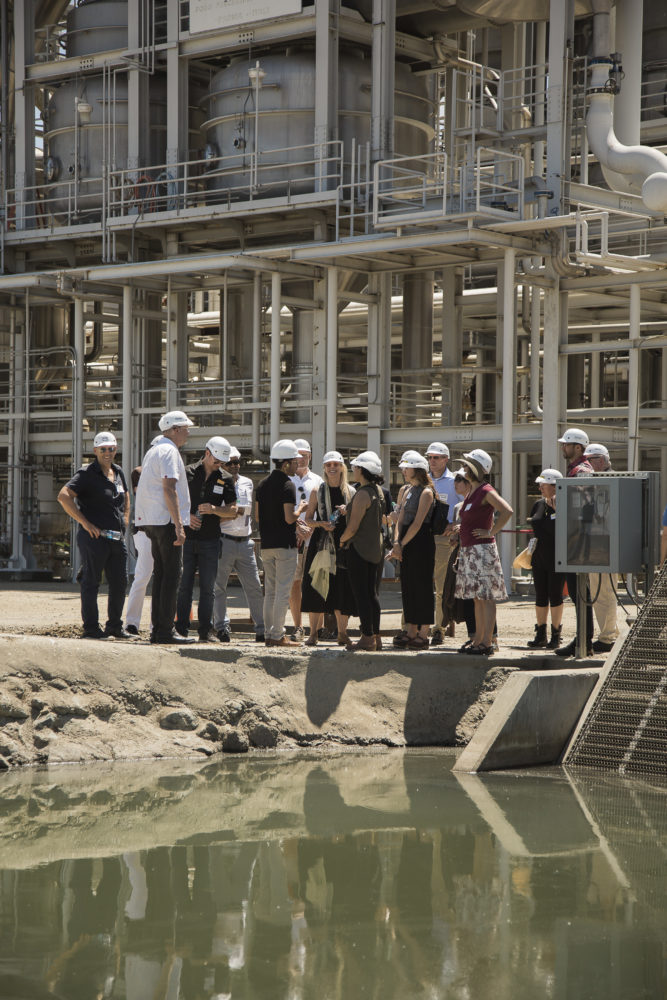
In the Central Valley between July and October, it is common see a semi filled to the brim with tomatoes. That truck is most likely head to Morning Star or another one of the dozen tomato processing facilities in the Central Valley. After our visit to General Produce, we headed to Williams about 1 hour north of Sacramento to the Morning Star Tomato Processing Plant. The drive up the I-5 freeway was quiet and scenic, with endless rows of walnut and apple trees against clear blue skies. Getting off the bus we were immediately exposed to the harsh Central Valley sun during the hottest July ever recorded in California’s history. While the Central Valley is known to have hot summers temperatures, several records have been broken in the past decade. The increasing temperatures are a symptom of climate change and also a key influence on farm food loss and disasters such as wildfires. Little did we know that we were only 30 miles away from the site of what would become known as the Mendocino Complex fire, the largest wildfire in California history that would start just 10 days after our visit. Claire Weisz, Ali Sants, and Amy Franchescini immediately put on their hats and prepared for the tour of modern industrial engineering’s solution to efficient food processing. The structure and surrounding landscape looked eerily similar to a coal mining plant. It was sterile, remote, place-neutral, and a highly controlled environment where we did not see a single tomato, or even a picture of a tomato, the entire length of the 1.5-hour tour.
We met with Joe Alonzo, an engineer from the Morning Star facility. He noted that 90% of the nation’s processed tomatoes come from California and that Morning Star processes more than any other tomato processing plant in California, processing 1,350 tons of tomatoes per hour for 100 days between July – October every year. The processed tomatoes go on to become ketchup, salsa, and canned tomatoes sold at grocery stores. Morning Star’s philosophy is Self-Management. They encourage innovation from all scales of within the labor hierarchy and several articles have been written about the success of Morning Star’s management style (e.g. Harvard Business Review 2014). They pride themselves in practicing promoting and encouraging innovations, happy employees, saving money, and more than anything, increasing efficiency.
When the facility receives a truck of freshly picked tomatoes they are inspected for quality and unloaded at the top of a human-made hill. Water and gravity make the unloading process quicker and more energy efficient. The majority of tomatoes are sorted for use in tomato paste and the rest are diced for salsa and canning. Cans of processed tomatoes may sit outside for 1-2 years before they are distributed.
At each stage of the tour, Tim explained the careful planning, design, and development of systems created to save time, energy, and money. It was difficult to keep track of all the design and engineering improvements they had made over the years.
We ended the day meeting with Post-doctoral researcher, Nicole Tautges, at the UC Davis Russell Ranch, a 300-acre agricultural research facility. We switched gears from learning about food distribution and processing to going to the source: soil. The State of California recognizes the importance of healthy microbes and their role in climate change through funding the California Healthy Soils Initiative , a collaborative effort to research the influence and impact of healthy soil. Research shows that healthy soil can improve water infiltration and retention, improve air and water quality, and sequester carbon, thereby reducing greenhouse gases. With this in mind, the facility has researched the long-term impacts that various farming methods have on soil. A key finding is that organic farming methods have shown to improve carbon sequestration and soil biodiversity. Dr. Kate Scow, Professor of Soil Science and Director of Russell Ranch, noted in the Washington Post, “With soil, there’s so much going on that is so close to us, that’s so interesting and multi-faceted, that affects our lives in so many ways, and it’s just lying there beneath our feet.”
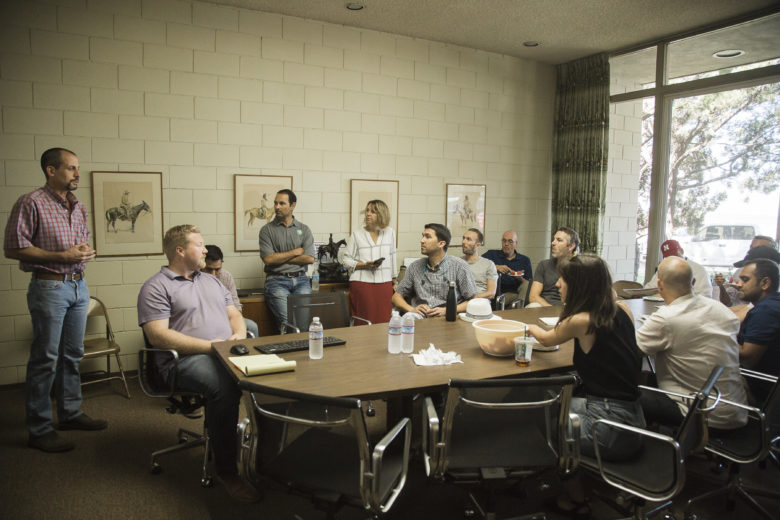
On the second day of the Climate Council trip, we ventured to Los Banos, in the heart of the Central Valley, to visit Bowles Farm. Bowles was a 4-hour drive south from Sacramento along the I-5 freeway, located in the San Joaquin Valley. The San Joaquin Valley is a place of extremes, with some of the richest and most fertile soil in California, the majority of the nation’s produce production, and some of the lowest life expectancy, highest crime rates, and worst air quality in the state. The 11,000-acre Bowles farm grows tomatoes, alfalfa, corn, cotton, melons, and dozens more fruits and vegetables. We met with Michael Cannon, owner and great-great-great grandson of “Cattle King” Henry Miller, one of the largest landowners in the US. Staff in attendance included Curtis Garner, Senior Farm Analyst; Derek Azevedo, Executive Vice President; and Danny Royer, Vice President of Technology. Later, Michael’s son joined in as a representative of the future farmers of California.
The Bowles team shared in-depth knowledge about the benefits and drawbacks of modern technology, the subtle and not-so-subtle changes in our climate, the impact of the drought, and inefficiencies in each stage of the food system. Conversations surrounding sustainability in the urban vernacular and lifestyle is recent, but for Bowles farm it has been a constant. Cannon states, “For us at Bowles Farming Company, ‘sustainability’ is part of everything we do. As a farming family with over 150 years of history, we understand what it takes to be sustainable. For us it is not just a catch phrase, it is a way of life.” They use gravity irrigation methods to save energy, have improved crop diversity in the past decade to increase crop yield and improve soil health (see above), and shared water with neighbors during the drought. They are by no means Luddites, using Landsat satellite images to manage cotton under variable soil conditions and to identify underperforming areas. Bowles uses a combination of technology and deep historical knowledge to manage their operation.
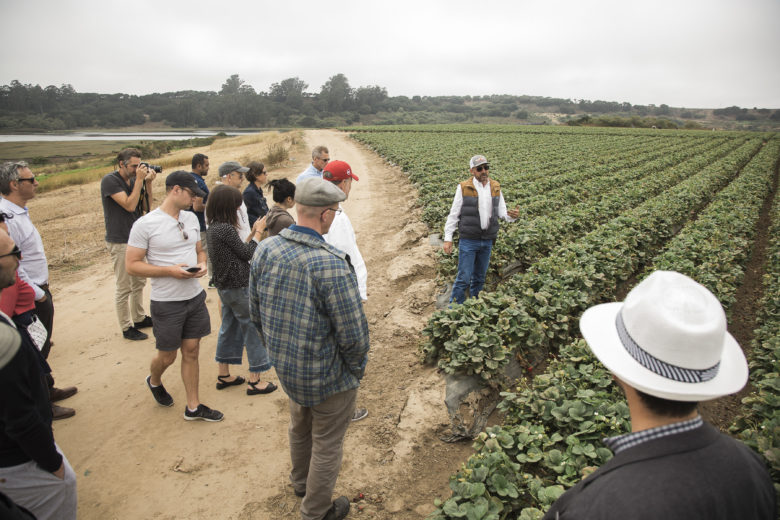
Our next stop was Salinas, one of the most prominent agricultural communities in the Central Coast where we met with Rick Tomlinson from the Strawberry Commission. Salinas is approximately 2 hours south of San Francisco and one of the only areas that is suitable for strawberry growth. Strawberries are the 3rd most lucrative crop in California, exceeded only by grapes and almonds. This is partly because 80% of the strawberries in the US are grown on the Central Coast. The land is particularly well suited to grow strawberries, with 10x higher yields than Washington.
Most of the strawberries are sent to US, Canada, and Mexico. A presentation to the Council by the California Strawberry Commission and Naturipe revealed that yet again, the multigenerational family farms stood the test of time. Strawberries, in contrast to tomatoes, are labor intensive and reflect minimal technological innovation. The presentation began with photos showing how strawberries were picked 60 years ago by Japanese-American farmers and how they are picked today: the images looked exactly the same.
We visited the strawberry fields, which were unexpectedly cold and located just a few minutes from the coast. The strawberries had been recently picked but we still saw large quantities of big, ripe strawberries on the plants. While we did not see anyone picking, we did see how laborious it could be. Even simply walking through the fields, Kishore Varanasi helped several of the council members as we stumbled through the fields losing our balance and some shoes along the way.
Every place we visited struggled with a variety of different issues but a common theme was labor and the changing politics of immigration. California agriculture has relied on a porous border that allowed legal movement between Mexico and the U.S. This enabled migrant laborers to travel back and forth over the border between seasons. Housing is only a part of the struggles that migrant laborers face. Seth Holmes describes the health impact of the current food systems on migrant laborers in his book, Fresh Fruit, Broken Bodies: Migrant Farm Workers in the United States. General Produce, Morning Star, Bowles, and Naturipe all showed genuine concern for the laborers, their working and living conditions, and expressed a desire to provide good working conditions albeit in short-term, tenuous jobs. General Produce mentioned the impact of the controversial Electronic Logging Device Mandate for truckers that was implemented in January of this year. Morning Star discussed the need for short-term housing for seasonal employees closer to the processing facility. Similarly, laborers at Bowles tended to follow the crops and move when the harvests are ready, requiring flexible, short-term housing. Naturipe’s need for specialized labor for a relatively longer season allowed laborers to stay in longer term housing but at coastal city prices.
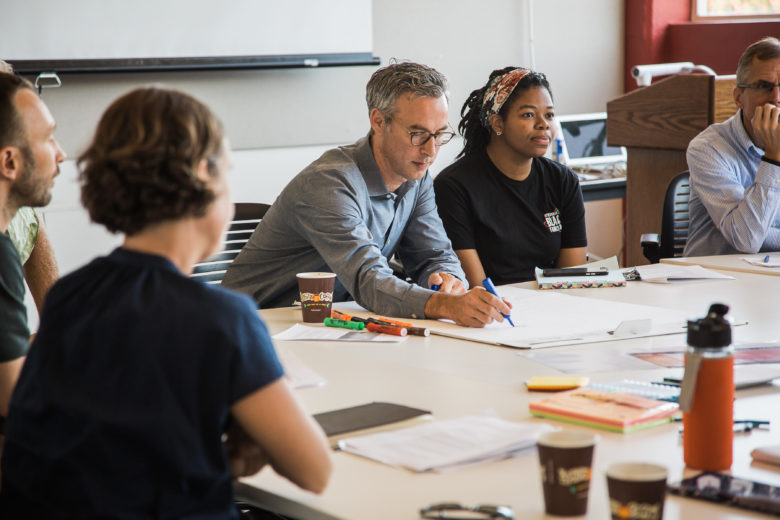
The final day of the trip was a workshop at UC Davis with local experts coming together to discuss the future of food. What we found was that the issues facing the current food systems are a result of complex interactions between social, environmental, political, and behavioral drivers operating at multiple temporal, economic, and spatial scales. The increasing efficiencies of our modern food system have dislocated and segmented the different nodes so that consumers lack understanding of how their children’s apples made it to the grocery store.
The urban – rural disconnect became the focus of a charrette on the final day of the trip, a topic that has received much-needed attention in California . Van Alen Executive Director David van der Leer posed the question, “How can designers and farm communities learn from one another in tackling regional challenges and inefficiencies brought about by climate change?” The Climate Council, consisting mostly of people who live, work, and design in urban areas were asked to bring their expertise from their respective backgrounds, collect their thoughts from what they learned from the visit, and discuss the direction we are headed and opportunities and challenges of our nation’s food system. Gary Sorge from Stantec commented that when he looked up “farmer” on his phone he found oversimplified, outdated, and offensive definitions of the term: “a person who farms; unsophisticated person from a rural area, a yokel.” This begged the question, if the definition of a term such as “farmer” is so outdated, what else about our understanding of agriculture is also outdated and misunderstood? Everyone we met during this trip was articulate, knowledgeable, and concerned about the future of our food; they are far from unsophisticated.
The discussion brought together diverse thoughts about the issues, each person bringing a different lens and perspective to what they experienced on the tour. Barbara Wilks presented an interesting angle, asking how solutions to housing, labor, and resources could fit under “quality of life” which would include environmental and public health. As we uncover the layers of the food system, it is imperative to reflect on how we view the world and its problems.
We ended our third day at Coyote Hills Regional Park in Union City, located about 30 miles southeast of San Francisco. We took a half-mile stroll along the creek, experiencing the revitalization of a landscape and providing relief from the long hours spent on the road. Resilient By Design Public Sediment team members Brett Snyder, Adam Marcus, Margaret Ikeda, and Victoria Chau presented the idea of the bay as living infrastructure that was the driving theme for the project The Resilient By Design competition which mirrored New York’s 2013 Rebuild By Design Challenge, an initiative that Van Alen helped lead after Hurricane Sandy. The challenge was to develop and strengthen climate resiliency through collaborative and community-based solutions.
On our drive home, we drove past a truck filled to the brim with tomatoes. It was a very fitting way to end this enlightening tour.
